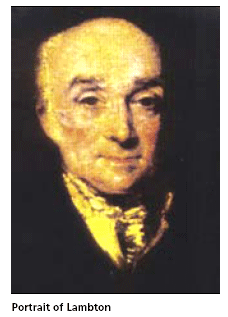| History | |
Everest back in India 1822-1825
|
|
||||||||||
|
Everest arrived back in India at the end of 1821 and then had to trek some 300 miles from Hyderabad to meet up with Lambton at Takalhera. This led to Everest starting work on the series from the meridian arc towards Bombay. The countryside and climate here was much more to his liking but it did require the use of towers to achieve long sights. It was here also that Everest converted to making night observations and the use of the vase lamp instead of opaque targets. By this time Lambton was driving himself to his limits especially considering his advanced years and on 18 September 1822 he wrote to Everest that he was handing the large theodolite over to him together with various other equipment and 26 coolies for their carriage. Lambton expressed his confidence in Everest’s ability, so much so that he declined to issue detailed instructions. In 1822 the Takalkhera base of 37 912.56131 feet was measured along the ground by means of a chain stretched between two small wooden capstans placed one at each end [3] When Everest and his team had reached about 76º E, around halfway towards Bombay on the new arc, he received the news on 3 February that Lambton had died at Hinganghat on 20 January 1823. At the time Lambton had been accompanied by Dr Morton, an assistant surgeon. For the last month of his life he had been declining rapidly, although he had persisted in pushing forward. Everest immediately ceased his triangulation and returned to Hyderabad. Unfortunately in the interim Dr Morton, as an executor, disposed of Lambton’s property as well as a number of Government items before Everest arrived. In addition he had moved a number of public documents to Hyderabad. [2] Everest assumed immediate control of the Great Trigonometrical Survey although at that time he had yet to be officially appointed to the post. This formality was to come on 7 March 1823 when he became the second Superintendent of the GTS. Everest was furious but too late to stop the hurried sale of Lambton’s effects. In particular among the public papers were apparently the plans, records and manuscripts covering 23 years of field work. Everest made all haste to meet Morton and salvage what he could from the mess that had been created. Acrimonious correspondence was exchanged and the whole affair rumbled on into June. Although Everest considered that he had managed to recover all the official material, he was still unhappy about the disposal of various personal items that he considered should not have passed to outsiders. From the time of taking over until August 1823, Everest was occupied with the mass of accompanying administration and at the same time he had yet another bout of fever, this time accompanied by rheumatism and partial paralysis, so that he was a semi cripple for the next two years. This he graphically described in [1]. Although advised by the medical men to go on leave immediately he was obstinate to the extreme in wishing to carry on with the programme he had set himself. The subsequent base measurement at Sironj in 1824 gave 38 411.89912 feet and was another of those occasions when Everest considered that he had to do everything himself because of the shortage of staff upon whom he could rely. He even supervised the driving of every picket, the reading of the ten thermometers and checking the free movement of the weight. This base was measured on coffers. On several occasions Everest had bemoaned the fact that among his assistants he had none who had a particle of mathematical knowledge beyond decimals, the use of Taylor’s Logarithms, and the square and cube root. [1] After closing the gap to Sironj he had to accept that he needed sick leave and on 25 May he began the journey first to the Ganges and then by river to Calcutta. [1] He sailed on 11 November 1825 bound for England.
References1Everest,G., 1830. An Account of the Measurement of an arc of the Meridian between parallels of 18º 3’ and 24º 7’. Parbury Allen & Co. London 2. Phillimore, R H., 1954. Historical Records of the Survey of India. Vol. III 1815-1830. 3. Smith, J.R., 1999. Everest. The Man and the Mountain. Whittles Publishing. Scotland.
| ||||||||||














 (4 votes, average: 4.75 out of 5)
(4 votes, average: 4.75 out of 5)




